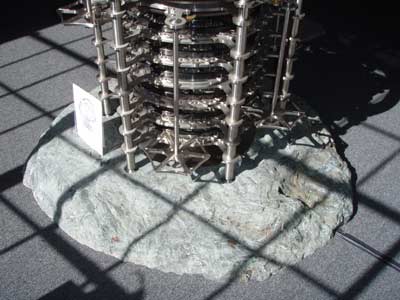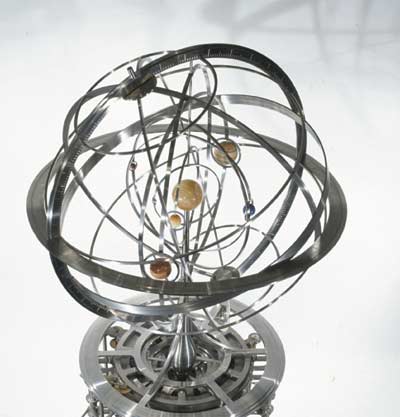
Orrery

This is the first working prototype of the Orrery, or planetary display for the 10,000 Year Clock. This prototype was just recently re-installed at our San Francisco Museum & Store. This part of the clock might help future visitors understand other parts of the clock by accurately showing the positions of the human eye visible planets – Mercury through Saturn. The lower six layers each make a binary mechanical calculation for one of the six planets above. It is designed to make one calculation tick at noon, and again at midnight to update the planet positions. However this display model may be activated at any time, and if you come by feel free to ask for a demonstration.
A new stone base was fabricated for the Orrery recently by the amazing stoneworkers of Seattle Solstice. We wanted a base that showed what this part of the Clock might look like if it were in natural rock. Seattle Solstice sourced a serpentine boulder from a nearby construction site and carefully sliced the top 6 inches off with a wire saw. They then machined pockets for the feet and drive mechanisms so the Orrery would drop right in. You can now see this mashup of stone and metal on display at our Museum & Store.
The Orrery was conceptualized by Danny Hillis, project management and additional design by Alexander Rose, lead engineer was Paolo Salvagione, and lead machinist and fabricator was Christopher Rand. Other machinists include Erio Brown, Brian Roe, Mark Ribaud, Reason Bradley, General Precision, Oakland Machine Works, Jim Johnson, Brian Ford, Ebin Stromquist, and the base was fabricated by Seattle Solstice
All engineering for the Clock of the Long Now is done in Pro Engnineer courtesy of PTC. All CAM processing is done in GibbsCAM courtesy of Gibbs & Associates. The Long Now Foundation thanks them for their support.

Join our newsletter for the latest in long-term thinking
Subscribe